
The higher the magnification, the bigger the increase in apparent size of a given object.
For example, an object 1,000 meters away when viewed with 10x binoculars appears only 100 meters away, or 10 times (X) larger than with the naked eye.
Higher magnification does not necessarily mean better.
If the magnification is too high, the object does not appear clearly due to binocular shake (caused by a slight trembling of the hands. ) Generally, binocular shake is not a problem with magnifications of up to 8x. You can also use binoculars with a 12x magnification without binocular shake once you become familiar with them.
Generally, the higher the magnification, the narrower the real field
of view, and the lower the brightness. Take 7x35 and10x35 binoculars
(both featuring objective lenses with the same effective diameter) for
example. Although the object appears bigger when looked at through the
10x35 binoculars than through the 7x35 model, the lower magnification
model offers a much brighter image and a wider real field of view. It
is therefore important to choose binoculars with an appropriate magnification.


Real field of view
As shown in the figure below, the real field of view is the angle of the visible field measured from the central point of the objective lenses.
The bigger the value, the wider the field of view, and the easier it
is to locate the object. (Note that some binoculars from other manufacturers
have excessively widened fields of view, which produce a distorted image
around the edge. )
The wider the field of view the better for watching moving or large-scale objects.
Apparent field of view
The apparent field of view is the visible breadth as seen through the
binoculars.
It is obtained by multiplying the real field of view by the magnification.
For example, in case of the 7x35 8.3 binoculars :
Real field of view : 8.3
Apparent field of view :
8.3 (real field of view) x 7 (magnification) = 58.1
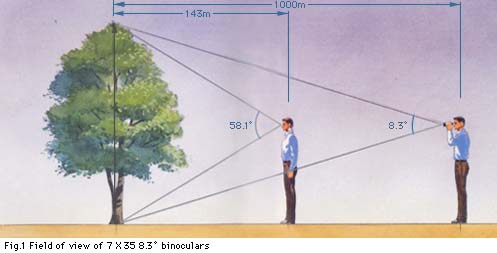
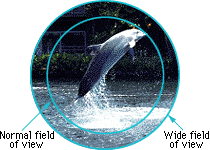 Wide field of view
Wide field of view
Binoculars with an apparent field of view greater than 65° are defined as wide field-of-view types according to the Japanese Industrial Standard (JIS).
These binoculars are designed to maintain a wide real field of view even at a high magnification. Several wide field binocular models are available from Nikon.
Eyepoint and eye relief
Eye relief is the distance between the eyepiece and the eyepoint. When you place your eye correctly at the eyepoint, you can see the whole field of view without any shading. If the eye relief is too short, you cannot place your eye at the eyepoint and the field of view is partially shaded off. High eyepoint binoculars with longer eye relief
(15 mm or longer) are recommended for eyeglass wearers.

eyecup folded |

eyecup unfolded |

Exit pupil
The exit pupil is the bright circle as seen on the surface of the eyepiece from about 30 cm (1 feet) away when you point the objective lenses toward a bright light.
The bigger the exit pupil, the brighter the image. The diameter of exit
pupil is calculated using the following equation :

Binocular brightness depends to some extent on the diameter of the human pupil.
If you use binoculars with an exit pupil diameter nearly the same size
as your own pupil, the light entering the binoculars will reach the
eye most efficiently.
 As a human pupil normally opens 2 to 3 mm in daylight, binoculars with an exit pupil of around 3 mm will provide sufficient brightness. (Refer to Fig. 2. ) However, the human pupil extends to about 7 mm in the dark, so binoculars with an exit pupil diameter of around 3 mm provide insufficient light in the dark, resulting in a dark image. (Refer to Fig. 3. )
As a human pupil normally opens 2 to 3 mm in daylight, binoculars with an exit pupil of around 3 mm will provide sufficient brightness. (Refer to Fig. 2. ) However, the human pupil extends to about 7 mm in the dark, so binoculars with an exit pupil diameter of around 3 mm provide insufficient light in the dark, resulting in a dark image. (Refer to Fig. 3. )
Binoculars with an exit pupil diameter of around 7 mm are thus best suited to astronomical observation and night surveillance.
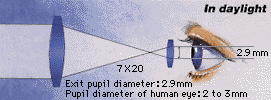
Fig. 2 |

Fig. 3 |
Relative brightness
Relative brigntness is obtained by squaring the exit pupil. As with
the exit pupil, the greater the relative brightness, the brighter the
image.
Look at the exit pupil on the surface of the eyepiece from about 30
cm (1 feet) away and check if it is perfectly round.
Some binoculars available on the market have an imperfectly round exit pupil, due to improper prism material. This will cause loss of light, resulting in reduced image brightness. Needless to say, the exit pupils on Nikon binoculars are all perfectly round and clear.

perfectly round exit pupil |

shaded exit pupil |
Effective aperture of the objective lens
The effective aperture is an opening of the objective lens through which light
can pass without eclipse. Generally, the inner diameter of an objective
lens is specified as the effective aperture. However, some manufacturers
show only the diameter of the objective lens as the effective aperture
of the lens, although the actual effective aperture is smaller than
the value shown. 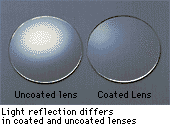
Remember, the larger the effective aperture, the greater the resolving
power, and the brighter the image. But increasing the effective aperture
of an objective lens means bigger, heavier binoculars. An effective
aperture of 50 mm is generally the limit for manual operation.
Lens coating
Lens coating plays an important role in improving image brightness.
When light passes through a lens, some light is reflected by the front and rear surfaces of the lens. This light causes flare or ghosting, reducing image sharpness and contrast.
Vacuum-vaporized coating puts a thin, transparent film on the lens surface which minimizes these adverse effects.
Most Nikon binoculars incorporate multilayer coated lenses covering a wide range of light wavelengths, ensuring brilliant, clean images even in dim light.
Transmission factors for uncoated lens surfaces, lenses with a single
coating, and lenses with multilayer coating are shown in the following
table.
Since several lenses and prisms are used in binoculars, differences
in transmission factors become greater as the number of lenses increases.
(See the table below. )
Transmission factor
|
Per single lens surface |
10 lens and prism surface |
| No coating |
96% |
(0.96)10 = 0.66 (66%) |
| Single - layer coating |
98.5% |
(0.985)10 = 0.86 (86%) |
| Multilayer coating |
99.5% |
(0.995)10 = 0.95 (95%) |
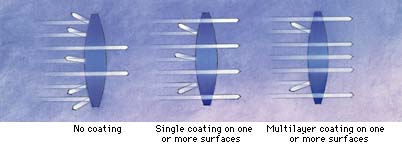
|






 Wide field of view
Wide field of view

 As a human pupil normally opens 2 to 3 mm in daylight, binoculars with an exit pupil of around 3 mm will provide sufficient brightness. (Refer to Fig. 2. ) However, the human pupil extends to about 7 mm in the dark, so binoculars with an exit pupil diameter of around 3 mm provide insufficient light in the dark, resulting in a dark image. (Refer to Fig. 3. )
As a human pupil normally opens 2 to 3 mm in daylight, binoculars with an exit pupil of around 3 mm will provide sufficient brightness. (Refer to Fig. 2. ) However, the human pupil extends to about 7 mm in the dark, so binoculars with an exit pupil diameter of around 3 mm provide insufficient light in the dark, resulting in a dark image. (Refer to Fig. 3. )



